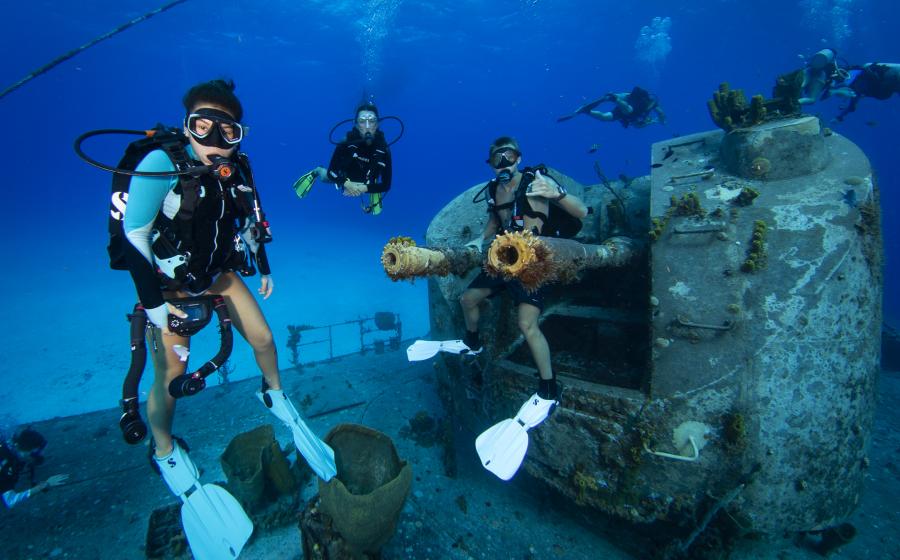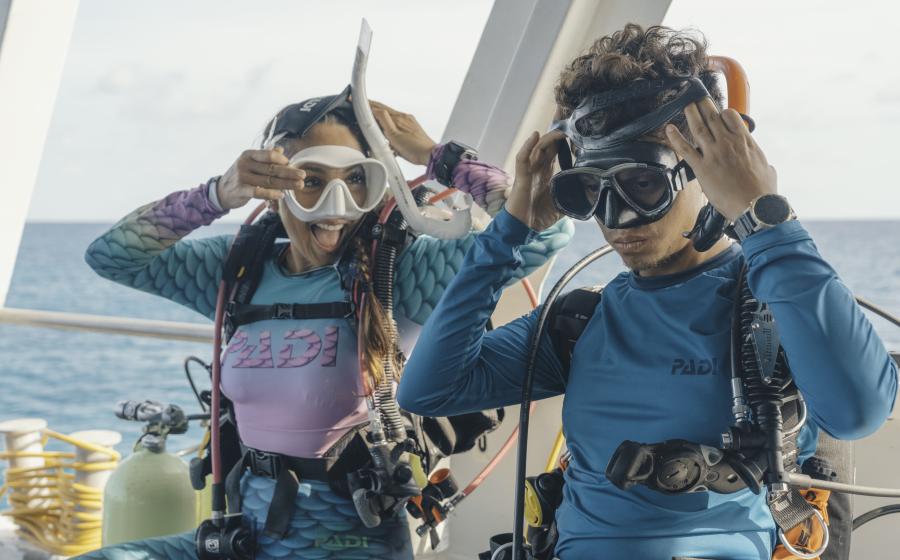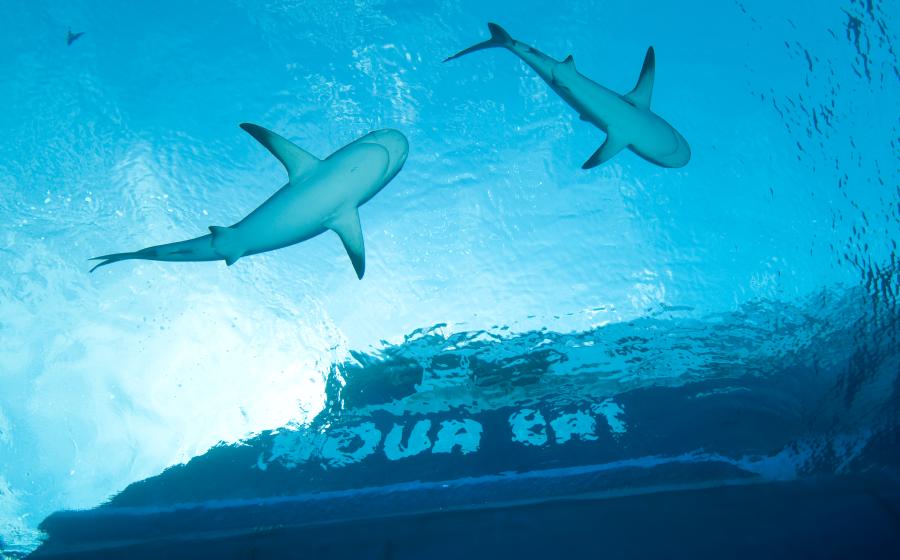Beat Camera Floods
 |
| My Nikonos RS flooded while I was shooting at Gibbs Cay. Fortunately, I had a backup. |
November 2004
Text and Photography by Stephen Frink
I'll never forget my first flooded camera. It happened on a drift dive in the Florida Keys in 1980. We were working off a live boat, and I jumped in holding a Nikonos II with an old (even then) Seacor 21mm lens. The wide lens housing slapped the water and dislodged the sealing O-ring. It was a full flood, both camera and lens, and, at a time when I could ill-afford repair bills, this was a big disaster. Now, 24 years later, I'm still flooding cameras. Recently, I was on a commercial shoot in the Turks and Caicos and flooded two systems. But there was a big difference in how these two mistakes happened, and what I had to do to fix them.
The first flood happened on the wreck of the Endymion off Salt Cay. I was 10 minutes into the dive when I heard the beep of my housing's moisture alarm. This particular housing (Seacam for Canon EOS-1D Mark II) has a highly absorbent black, flocked material coating the inside of the housing, so even though I could not see what was going on, I knew that there was a small amount of water inside--a big leak would have sounded the alarm much earlier. I safely assumed that osmosis had wicked the moisture to the alarm, and if I kept the housing in an upright position, localizing any moisture at the bottom of the housing, I could go back to the boat and check things out.
When I opened the housing, all the moisture had been absorbed by the flocking, and when I checked the housing, I found a hair across the port O-ring. I regreased all O-rings and used compressed air from a scuba tank to dry the inside of the housing. I was back in the water shooting 10 minutes later, with no concerns other than a significantly escalated heart rate.
Contrast that with a flood I had the next day with my Nikonos RS. We were shooting the stingrays off Grand Turk's Gibbs Cay in only five feet of water with both the RS and the housed digital. I kept going back to my staging area on the beach to change film in the RS. At the pace of this action, 36 shots lasted only about five minutes, and I'll admit by hurrying I did not service the O-ring with every film change. Predictably, the RS's finicky O-ring got pinched, forced out of the sealing groove, and I had a calamitous flood at the surface. Unlike the minor problem the day before, this one was potentially more troublesome and no doubt more expensive. (Of course, with a 2-gigabyte card in the digital camera, I just kept shooting, without opening the housing's back door. Increased imaging capacity is a big advantage of shooting digital.) I immediately removed the RS battery (the first corrective step on any and all electronic cameras that take on water), but a field repair on the beach was impossible.
Fortunately, I had backup camera systems and finished the job. All of this led me to ponder the occasionally extreme steps we have to take to keep our camera gear working in the field, and what steps are prudent to minimize the potential of water ending up on the wrong side of the O-ring.
Field Maintenance
Prepare a Tool Kit for the Road > Every shooter should carry a tool kit and know how to use it. Recommended tools include jeweler's screwdrivers (flat and Phillips), small crescent wrench, small vise grips, larger flat and Phillip's screwdrivers, Swiss Army knife, Allen wrench kit (either metric or imperial depending on your gear, or, more likely, both), penlight, superglue, electrician's tape and duct tape.
Carry Spare Housing Parts > Spare parts will vary from housing to housing, but your dealer should be able to suggest the parts necessary for a "Save-A-Shoot" kit. At the very least, it should include O-rings for main body and ports and replacements for oft-used springs like shutter releases.
 |
| Some of the tools every underwater photographer should have in his travel kit. |
Prepare for Strobe Failures > Sync cords are the most common part of a strobe system to fail. A spare sync cord should be a mandatory item in your travel kit. Likewise, a spare battery should also be included. Actually, traveling with only one strobe system is a bit risky, but at least that's something you might be able to rent.
Be Obsessive > Perform all camera and housing assembly in a clean, well-lit room, and--if you're like me--wear your reading glasses. The O-ring is the first line of defense against water intrusion, and if it is dirty, flat or cracked, it will let water inside. Be obsessive about this one crucial task. You need to be able to service the O-ring carefully, and that means seeing it well.
Use the Right O-ring Grease > This has become a big issue lately. When all we had was a Nikonos V and a few housings, one grease fit all. It could be petroleum-based or silicone-based. But now there are many specialty O-rings. A Nikonos RS requires Nikonos grease. Sea & Sea blue O-rings need special grease, which comes in the tube with the blue cap. Inon wants you to use its grease on the strobe O-ring, but Inon uses Sea & Sea cords, which require Sea & Sea grease. Ikelite's Substrobe 200 O-ring will swell up if you use Nikonos grease, but if you use Ikelite grease occasionally and sparingly, it's trouble-free. Personally, I'd rather carry one vat of generic O-ring grease that works for all gear, but that is no longer possible because there is no standardization among manufacturers. These are not just clever ploys to sell branded O-ring grease but very real precautions. Make sure you carry plenty of the right kinds of grease.
Rinse as Soon as Possible > Displacing salt water with fresh water is one of the most important post-dive maintenance tasks you can perform. You don't have to leave your camera soaking in the rinse bucket. In fact, you shouldn't, because more likely than not the next camera in the bucket will land on top of yours and scratch your dome. But don't skip the rinse bucket either, because if you let salt crystals dry, they'll be much more difficult to dissolve.
Take Strobe Cords Off Regularly > The strobe sync ports on both Nikonos cameras and housed systems can be problematic. Electrolysis will occur any place where electronics and salt water meet. I like to put a light coating of O-ring grease on the sync cord threads (in this case, the brand of grease does not matter). At the end of the day, I try to remove the cords. This keeps the threads on the sync port from eroding with electrolysis, and also gives me an opportunity to make sure that no water seeps inside.
Be Careful Where Your System Rides > I have seen too many housings pitched to the deck when a boat takes a rogue wave to believe that the rails on the camera table are perfect security. Even worse are systems left on dive benches that are perfectly secure while at anchor, but wildly insecure while underway. Probably the dumbest move I ever made was leaving my Nikonos system tied to a line off the side of the boat. That was convenient when I had to swap cameras under water, but after the third time I saw my camera system waterskiing in the prop wash on the way home, I realized I was too forgetful to use that particular trick.
Travel with Backups > I realize that, given the cost of underwater cameras and housings, having redundant systems is not always possible, but it is always advisable. Even though my digital system is my primary tool, I travel with both Nikonos RS and Nikonos V cameras, and sometimes even a housed Nikon F100. However, the hassle of flying with several cases of gear is definitely a problem with the airlines these days. I keep trying to streamline my travel kit, seeking to strike the balance between adequate preparation and the need to travel comfortably. In the next year I'll probably have redundant digital camera bodies and maybe even move away from film entirely. Any issue with a housing is likely to be fixable in the field, but a complex electronic camera body is beyond my ability to control or repair. If the camera body stops working for any reason, a spare is mandatory. Although, having said that, a Nikonos V, 15mm lens and 20 rolls of film don't take up much space, and it sure is a comfort to know an old standby is standing by.
|| |---|
| |
| My Nikonos RS flooded while I was shooting at Gibbs Cay. Fortunately, I had a backup.|
|
| My Nikonos RS flooded while I was shooting at Gibbs Cay. Fortunately, I had a backup.|
November 2004
Text and Photography by Stephen Frink
I'll never forget my first flooded camera. It happened on a drift dive in the Florida Keys in 1980. We were working off a live boat, and I jumped in holding a Nikonos II with an old (even then) Seacor 21mm lens. The wide lens housing slapped the water and dislodged the sealing O-ring. It was a full flood, both camera and lens, and, at a time when I could ill-afford repair bills, this was a big disaster. Now, 24 years later, I'm still flooding cameras. Recently, I was on a commercial shoot in the Turks and Caicos and flooded two systems. But there was a big difference in how these two mistakes happened, and what I had to do to fix them.
The first flood happened on the wreck of the Endymion off Salt Cay. I was 10 minutes into the dive when I heard the beep of my housing's moisture alarm. This particular housing (Seacam for Canon EOS-1D Mark II) has a highly absorbent black, flocked material coating the inside of the housing, so even though I could not see what was going on, I knew that there was a small amount of water inside--a big leak would have sounded the alarm much earlier. I safely assumed that osmosis had wicked the moisture to the alarm, and if I kept the housing in an upright position, localizing any moisture at the bottom of the housing, I could go back to the boat and check things out.
When I opened the housing, all the moisture had been absorbed by the flocking, and when I checked the housing, I found a hair across the port O-ring. I regreased all O-rings and used compressed air from a scuba tank to dry the inside of the housing. I was back in the water shooting 10 minutes later, with no concerns other than a significantly escalated heart rate.
Contrast that with a flood I had the next day with my Nikonos RS. We were shooting the stingrays off Grand Turk's Gibbs Cay in only five feet of water with both the RS and the housed digital. I kept going back to my staging area on the beach to change film in the RS. At the pace of this action, 36 shots lasted only about five minutes, and I'll admit by hurrying I did not service the O-ring with every film change. Predictably, the RS's finicky O-ring got pinched, forced out of the sealing groove, and I had a calamitous flood at the surface. Unlike the minor problem the day before, this one was potentially more troublesome and no doubt more expensive. (Of course, with a 2-gigabyte card in the digital camera, I just kept shooting, without opening the housing's back door. Increased imaging capacity is a big advantage of shooting digital.) I immediately removed the RS battery (the first corrective step on any and all electronic cameras that take on water), but a field repair on the beach was impossible.
Fortunately, I had backup camera systems and finished the job. All of this led me to ponder the occasionally extreme steps we have to take to keep our camera gear working in the field, and what steps are prudent to minimize the potential of water ending up on the wrong side of the O-ring.
Field Maintenance
Prepare a Tool Kit for the Road > Every shooter should carry a tool kit and know how to use it. Recommended tools include jeweler's screwdrivers (flat and Phillips), small crescent wrench, small vise grips, larger flat and Phillip's screwdrivers, Swiss Army knife, Allen wrench kit (either metric or imperial depending on your gear, or, more likely, both), penlight, superglue, electrician's tape and duct tape.
Carry Spare Housing Parts > Spare parts will vary from housing to housing, but your dealer should be able to suggest the parts necessary for a "Save-A-Shoot" kit. At the very least, it should include O-rings for main body and ports and replacements for oft-used springs like shutter releases.
|| |---|
| |
| Some of the tools every underwater photographer should have in his travel kit.|
|
| Some of the tools every underwater photographer should have in his travel kit.|
Prepare for Strobe Failures > Sync cords are the most common part of a strobe system to fail. A spare sync cord should be a mandatory item in your travel kit. Likewise, a spare battery should also be included. Actually, traveling with only one strobe system is a bit risky, but at least that's something you might be able to rent.
Be Obsessive > Perform all camera and housing assembly in a clean, well-lit room, and--if you're like me--wear your reading glasses. The O-ring is the first line of defense against water intrusion, and if it is dirty, flat or cracked, it will let water inside. Be obsessive about this one crucial task. You need to be able to service the O-ring carefully, and that means seeing it well.
Use the Right O-ring Grease > This has become a big issue lately. When all we had was a Nikonos V and a few housings, one grease fit all. It could be petroleum-based or silicone-based. But now there are many specialty O-rings. A Nikonos RS requires Nikonos grease. Sea & Sea blue O-rings need special grease, which comes in the tube with the blue cap. Inon wants you to use its grease on the strobe O-ring, but Inon uses Sea & Sea cords, which require Sea & Sea grease. Ikelite's Substrobe 200 O-ring will swell up if you use Nikonos grease, but if you use Ikelite grease occasionally and sparingly, it's trouble-free. Personally, I'd rather carry one vat of generic O-ring grease that works for all gear, but that is no longer possible because there is no standardization among manufacturers. These are not just clever ploys to sell branded O-ring grease but very real precautions. Make sure you carry plenty of the right kinds of grease.
Rinse as Soon as Possible > Displacing salt water with fresh water is one of the most important post-dive maintenance tasks you can perform. You don't have to leave your camera soaking in the rinse bucket. In fact, you shouldn't, because more likely than not the next camera in the bucket will land on top of yours and scratch your dome. But don't skip the rinse bucket either, because if you let salt crystals dry, they'll be much more difficult to dissolve.
Take Strobe Cords Off Regularly > The strobe sync ports on both Nikonos cameras and housed systems can be problematic. Electrolysis will occur any place where electronics and salt water meet. I like to put a light coating of O-ring grease on the sync cord threads (in this case, the brand of grease does not matter). At the end of the day, I try to remove the cords. This keeps the threads on the sync port from eroding with electrolysis, and also gives me an opportunity to make sure that no water seeps inside.
Be Careful Where Your System Rides > I have seen too many housings pitched to the deck when a boat takes a rogue wave to believe that the rails on the camera table are perfect security. Even worse are systems left on dive benches that are perfectly secure while at anchor, but wildly insecure while underway. Probably the dumbest move I ever made was leaving my Nikonos system tied to a line off the side of the boat. That was convenient when I had to swap cameras under water, but after the third time I saw my camera system waterskiing in the prop wash on the way home, I realized I was too forgetful to use that particular trick.
Travel with Backups > I realize that, given the cost of underwater cameras and housings, having redundant systems is not always possible, but it is always advisable. Even though my digital system is my primary tool, I travel with both Nikonos RS and Nikonos V cameras, and sometimes even a housed Nikon F100. However, the hassle of flying with several cases of gear is definitely a problem with the airlines these days. I keep trying to streamline my travel kit, seeking to strike the balance between adequate preparation and the need to travel comfortably. In the next year I'll probably have redundant digital camera bodies and maybe even move away from film entirely. Any issue with a housing is likely to be fixable in the field, but a complex electronic camera body is beyond my ability to control or repair. If the camera body stops working for any reason, a spare is mandatory. Although, having said that, a Nikonos V, 15mm lens and 20 rolls of film don't take up much space, and it sure is a comfort to know an old standby is standing by.






